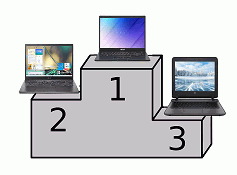HOW ARE LAPTOPS TESTED?
When you set out to buy a new laptop, the first thing you are most likely to do is to read the reviews regarding the laptop you intend on purchasing. Laptop testers go all in to make sure that such reviews are unbiased and give you an accurate insight of a laptop’s potential. Laptop testers have professional knowledge of all the parts of a laptop ranging from display to battery to performance. Before the testing starts, other competing laptops with matching sets of specifications are chosen to compare with the current laptop and set a fair threshold for testing.
Shared below is an in-depth analysis of how different aspects of laptops are extensively tested:
Performance
This is the most common element many buyers look for in their laptop. There is a whole range of tools that can be used to benchmark the performance of a laptop under different simulated usage scenarios; word processing, video streaming, picture editing, video rendering and gaming are a few to name. The following are some tools that help to test the performance of a CPU.
Geekbench is omnipresent in the realm of benchmark testing. Geekbench’s CPU Benchmark makes the device perform a few complex tasks to provide a quick image of the laptop’s productivity. It outputs its results as single-core and multi-core scores which can be compared across devices.
Maxon’s Cinebench is another powerful tool to get an impression of a laptop’s number processing potential. Its 4D engine renders a very complex scene which pulls all the cores and threads of the processor to their extremes.
Handbrake is a video transcoder. Testers use uniform settings across devices to get an insight of the laptops ability to sustain heat intensive processing tasks over a period of time. A lower output time is better as it is a timed test.
PCMARK 10 is a multi-purpose tool. It provides a numerical score for the performance of a laptop in everyday tasks as well as shines light on the system’s storage abilities and boot times. The tool also takes into account the newer PCI and NVMe architectures and the older SATA architecture and reflects into the differences caused by these drives.
Graphics
Laptops with a dedicated GPU or those advertised as gaming laptops are put under further tests to check their graphics processing abilities.
GFXBench is an inter-platform graphics benchmark. It tests both low and high stress aspects under stress. It has various subtests that can be performed to obtain scores which can be compared across competing devices as well as other platforms.
3DMARK provides a range of GPU related and software API tests. Each of the tests reports a score that is used for comparison.
Apart from these simulated tests, laptops also undergo real world gaming tests in each of the 3 most common game types namely an AAA game, a shooting sport and a driving simulator. All these types of games stress the GPU in distinct ways. Laptop testers have already decided which games to test under each category. They take into account real-time factors like the frames per second (fps) and the maximum resolution and game modes a laptop can support. Such numbers are great for comparing a laptop with others with the same specs or price.
Display
The brightness of a display is a measure of its luminosity. The brighter a display is, the easier it is to use in well-lit conditions. Its unit is “nits” and it is measured by a type of tool called colorimeter. The same tool also gives the value of color gamut for different spectrums.
The finish of the display is also vital in determining its performance because problems such as glare are caused by glossy finish and low brightness. Laptops are tested under varying lighting conditions with different brightness to evaluate their overall performance. If a device supports touch or stylus, it is also tested accordingly. Aspects such as refresh rate and screen tearing are also tested for, especially in gaming laptops.
Battery
The battery life of a laptop could be a decision changing factor while making a purchase. How long a fully charged battery lasts depends on the tasks it is performing, the laptops brightness, screen resolution and the performance settings chosen by the user.
To get a fair idea of a laptop’s battery life, it needs to be tested in similar conditions and settings as other laptops. These include brightness, performance settings, wireless connections, background programs and antivirus. After a laptop has the similar condition as other tested laptops, it is given the same tasks as them to check how long the battery lasts.
Tools, such as the earlier mentioned PCMARK 10, can also be used to check a laptop’s battery under simulated workloads. Moreover, a laptop’s charging time from 0% to 100% by its genuine charger is also evaluated.
Subjective Tests and Rating
After running all the above mentioned tests, laptop testers run subjective checks. They use the keyboard and trackpad for a long time to understand their response and the laptop’s ergonomics. They also carry around the laptop for some time to evaluate its portability. The functionality of the hinges as well as the ease of upgrading of internals is also taken into account.
Finally, the laptop testers sit together and assign the laptop an overall rating based on how well it performs in their tests and in comparison to other laptops.

